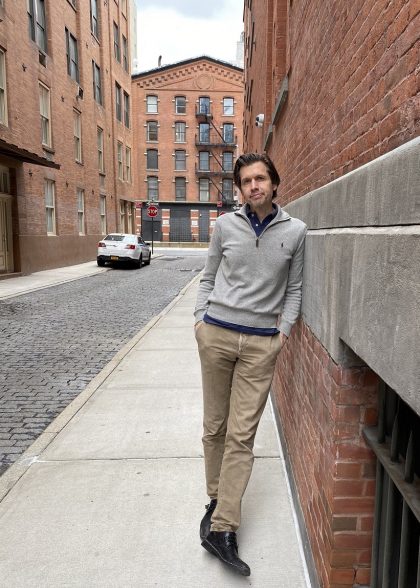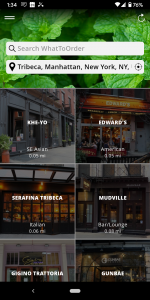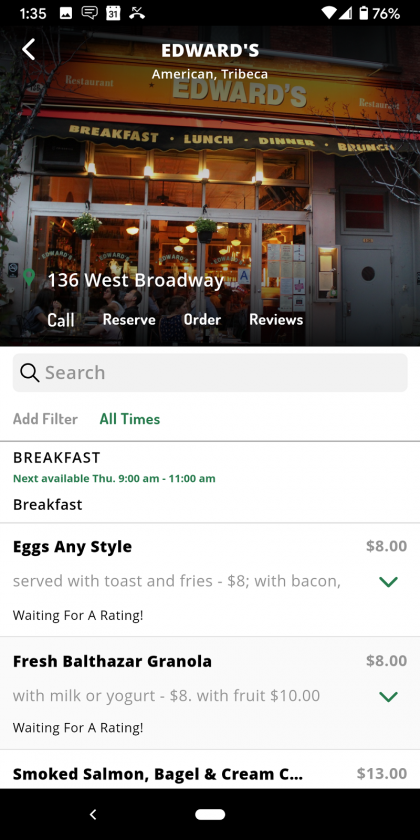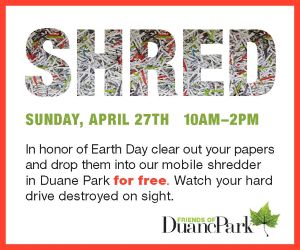Categories
Left column house ads
New App on the Block: WhatToOrder
April 29, 2020 Community News, Restaurant/Bar News
A few years ago, Hubert Street resident Rob Fraley got to thinking it would be a cool idea to be able to rate individual dishes at restaurants, so when you got there, you’d know what to order. Fun, yes, but he soon realized that there could be more to it. Once he built the database, diners could actually search for specific dishes — let’s say duck a l’orange (don’t ask why that popped in my mind; can’t tell you) — or a specific ingredient (if, for example, you were jonesing for ramps).
“It started out as something a lot more superficial,” said Fraley. “But you still had to have a comprehensive database, and the challenge of that is 100 times harder than a rating system. So once I made it searchable, it morphed into something better.”
But then he realized he had something that would not only work for eaters, it could be a boon to small restaurants AND he could mine the data to send reports to food providers, who might actually pay for that. (More on the latter below.) He had read the TC piece on GrubHub/Seamless fees and thought the city’s independent restaurants deserved to be freed from the tyranny of delivery apps.
And so was born WhatToOrder, launched on April 9, an app that allows users to search for any single item on a menu, even the name of a farm. So far his database includes 6500 sit-down restaurants in New York City — for a total of 370,000 menu items and ingredients — and the app’s current users have already searched for 3000 individual terms. (Excluded are any of the chains, especially the ones that have their own apps.) (And, they guess they have about 85 percent of the city’s sit-down restaurants overall — so there would be another 1200 to go. They are also starting to add some takeout places that don’t offer seating.)
And wait, there’s more! It also has a role in the pandemic: he applied a filter to the app for now (you can deactivate it) that sorts restaurants currently open for delivery and pickup. To do that, he had his team check in with every one of the restaurants currently on their list to get updates (and learned in the process that 65 percent are closed).
“It’s not a pivot, but it’s a feature modification that we added once everything locked down,” Fraley said. “When the pandemic was setting in, we realized we could do a real service for restaurants.” Since restaurants continue to close and open, the staff has found it tough to keep up, so Fraley is adding a “report” button so the team can crowdsource updates.
What the app does for restaurants is serves as an equalizer: neither users nor restaurant owners are charged to use it, whereas delivery apps charge restaurants to be higher on the search list or take a percentage of sales. Diners can still link from WhatToOrder to their preferred delivery service, but if more users shift to WhatToOrder, the restaurant can then take a delivery contract at the lowest tier. Diners can even search for restaurants that use a specific delivery app. “People will only do so much — they won’t inconvenience themselves too much to help restaurants,” said Fraley, “so we had to make it easy.”
So back to the big food piece: Fraley met with some of the giants — companies like Nestle and Kraft — and learned that they have scouts who travel around the country looking for trends in the restaurant industry. But they can only cover so much ground and it’s hard to aggregate the data. That’s what WhatToOrder can sell: both the aggregated data from the listed menu items and the search terms entered by users, so they can see what’s hot. “If they can get one good idea a month for a product, then that’s a win.”
Fraley worked on Wall Street for 20 years, quit in 2016 and has been building the app ever since — and no wonder, since the data was collected by searching for every sit-down restaurant in the five boroughs block by block on Google Maps, downloading menus and entering in every ingredient listed. (“If we’ve missed them, it was not on purpose.”) He estimates that 60 to 70 percent of items never change, but 30 to 40 change every year — meaning he will have to absorb 270,000 changes to the database every year to keep up.
But when you’re hankering for sriracha jam or saffron bouillabaisse or umami burgers, this will scratch the itch.
“If we keep this updated, then people are not going to find this anywhere else — not on Google, not on GrubHub, only on WhatToOrder.”
7 Comments
Comment:
Subscribe
Subscribe to the TC Newsletter


















This is great! However, I don’t see Zuckers Bagels on Chambers Street. They are doing delivery and takeout til about 2:30.
Sorry, we’ll add them right away. We started off with places that met the traditional definition of restaurants, and have been widening the scope ever since.
We’ll get the location up shortly, including the links to their delivery options (including their own ordering system), and then have the regular menu up a bit later this afternoon.
I’ll try to get down there to take a photo today as well.
Thank you for the reminder!
Ok, it’s up, and menu fully searchable!
interesting idea. can u tell us why this is better for the customer than seamless, etc? or is it mainly for restaurants better economics. also who does the delivery in your service?
Hi Joe, thanks for your questions.
It’s better for the customer because they will see more restaurant options than they will by searching any delivery or review app, and will see them sorted transparently.
Delivery apps only show you their silo of partners, and then alter the results to favor the larger restaurants. Yelp and Google Maps are very comprehensive of course, but also alter the search results.
Also, customers can search much deeper into menus to find specific dishes on WhatToOrder. Our research indicates that a portion of every consumer’s restaurant search activity is focused around something more specific than cuisine, or even food type (by food type I mean ramen, tacos, etc.). For those occasions, WhatToOrder is the only reliable option.
And for those with dietary preferences, or the desire to eat sustainably, we’ve combed through hundreds of thousands of menu items to tag those with some combination of 20 different filters. Again, there is no other reliable option if you want this.
WhatToOrder is not a delivery service. We are a search platform, but link users directly into the mobile delivery, reservation and review sites without having to open another app.
I guess you could sum all this up by saying our value add is providing consumers a single point of entry for all food and restaurants searches by giving them access to all available information in one place.
How does the app make money if not through ads priority search results or transactions?
Hi Ghazi,
We identify trends in both restaurant menu content and consumer demand for various foods (and eventually beverages) for restaurants and other businesses in the supply chain.
The idea is to provide near real-time market signals for food suppliers, including restaurants, so that they can better gauge demand for existing foods, and be alerted when new trends arise.
For consumers, it sort of puts them in the driver’s seat, so that they are determining, collectively, what types of products make their way onto menus and store shelves, merely by using the app, rather than having products they didn’t ask for being marketed to them.
By eliminating as much of the friction of food search as possible, particularly for sustainably produced goods, we hope to uncover the true demand for them.
The way our search engine works, it does not suggest alternatives. For example, if people are searching for grass-fed steak, only those results so tagged will show up. As the number of searches with this tag increase, so does the risk to restaurants and their suppliers of not carrying it.
For food companies, up to 70% of innovations in the consumer packaged good industry originate in restaurants. But their current methods for identifying those trends are highly inefficient, since collecting data from the restaurant industry is, as one executive told me, “the biggest black hole” in their industry.
We plan to price our data product, which is largely DIY, such that it is affordable to even the smallest restaurants, using a progressive pricing structure. Those restaurants, incidentally, tend to punch well above their weight in terms of the innovations they bring.